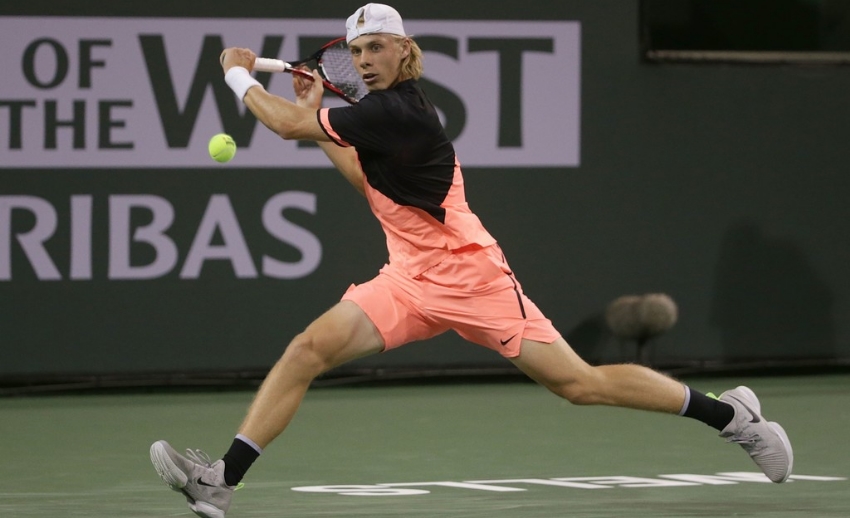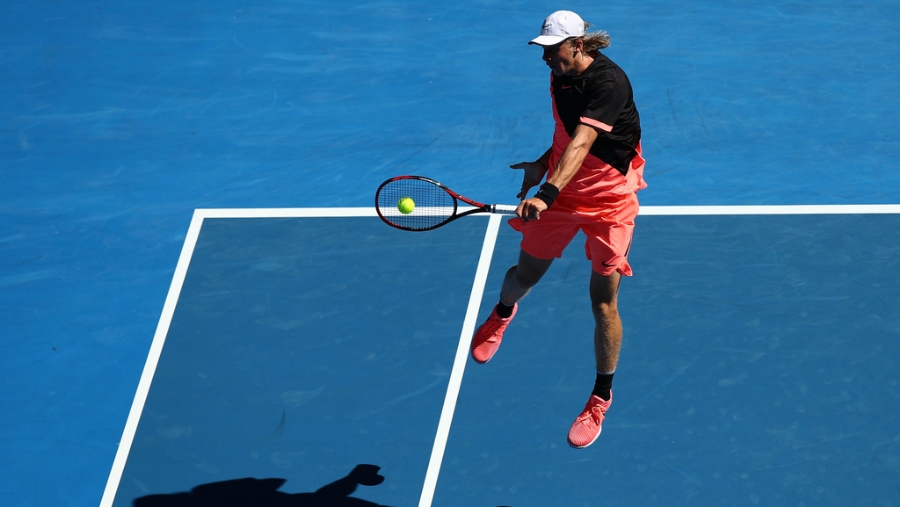We often hear that “stats can be misleading.” This phrase is indeed a misguided assumption. It can only be true if the person looking at the statistics of the match in question views them as nothing more than sheer numbers without engaging their critical thinking. It is a rare occurrence at best. In reality, the evaluator’s personal observations of the match, influenced by his/her expert knowledge of tennis, mobilize a certain level of critical thinking that should lead to a healthy post-match analysis. Stats can be useful ingredients during such process, but they merely play a complementary role to the two main components, personal observation and critical thinking. To be blunt, it is very possible to do a sound analysis of a match using these two components alone. It is, by contrast, highly improbable that the same can be done if we lacked one of the two components, even if we had every numerical data at our disposal.
Thursday’s first-round match between the left-handed Denis Shapovalov (Canada, ranked no.44) and the qualifier Ricardas Berankis (Lithuania, ranked no.106) provides a good example of how numbers can be misguiding if stats are mainly taken into account.

In the first game of the match, Shapovalov made his first serve only once in six total points, double-faulted once, yet still managed to hold serve. In the third game at 1-1, he committed another double fault, only hit half of his first serves in, but held serve again. In the fifth game at 2-2, he double-faulted twice to start the game and still dug himself out of the hole and held serve.
In fact, when the scoreboard showed 3-2, it almost seemed miraculous that Denis would still be on serve. Thus far in three serving games, stats showed that he committed four double-faults and got only seven out of seventeen first serves in at 41%. I prefer to say the following: Denis Shapovalov was serving so well that even at 41% first serves and four double faults, he had yet to face a break point and lost only one point on his serve outside of the four double faults.
Because, you see, the numbers could not tell you the story of how well Shapovalov was placing the first and second serves that he was getting in, how much variation his serves had in terms of spin and speed, or how many errors Berankis was making on returns as he would try to adjust to the different bounces coming off the Canadian’s wicked combination of flat, slice, and kick serves.
Neither could the numbers tell the story of what precisely happened in the four points that followed when Denis went down 0-30 at 2-2, after the two successive double faults. At 0-30, Shapovalov got in a high-kicking second serve that forced Berankis to hit a defensive return, eventually leading to a forehand winner by Denis. At 15-30, Shapovalov hit a slice first serve to the outside corner of the box, stretching Berankis to the outside of the court and forcing him to float the one-handed backhand out. At 30-30, Shapovalov struck a hard serve to the “T” that Berankis could not get back in the court. Finally, at 40-30, Shapovalov hit a clean ace to the outside, for good measure, and closed out the game.
Stats were showing a “bad serving day” for Shapovalov. To a careful observer however, it was clear that Berankis was having a “nightmare returning day,” precisely because of Shapovalov’s serving skills. Do you believe that, after Shapovalov held and went up 3-2, Berankis was getting edgy thinking what he would do if Shapovalov’s first serve began to truly click, considering how much trouble the Canadian’s “un-clicking” serve was already giving him? You bet he was! And that anxiety showed in the ensuing sixth game.
The same Berankis that cruised through his first two service games without losing a point became restless. He committed his first double-fault at 30-15. He escaped a break point at 30-40 with what was probably his best point of the match, a long rally ending with his forehand winner to the deuce corner. He squandered two chances to hold serve before saving another break point. Then, the pressure finally got to Berankis. He double-faulted a second time in the game on the fourth deuce point and gave Shapovalov his third chance to break. Berankis then missed a fairly routine backhand cross-court wide, and Denis was now out in front 4-2.
To confirm the break, Shapovalov served three successive first serves in, winning the ensuing rallies in each point, to go up 40-0. To finish the game, Shapovalov kicked a second serve so high that Berankis swung and almost completely missed the ball, his racket frame barely clipping the ball behind him. It was very symbolic of the havoc that Shapovalov’s serve was causing on the Lithuanian.
Yet, when the set ended 6-3 in Shapovalov’s favor, his serving numbers were unimpressive. He served at 48% first serves, recorded two aces and four double faults. It was rather the placement and the variation of both his first and second serves that did the damage not the amount of aces or first serves that he got it in the box.

It was déjà vu in the second set, except that Berankis did try to attack more by coming to the net. The problem was that he could never solve the puzzle of Shapovalov’s serves. For example, when he was leading 3-2 and 0-15 on Shapovalov’s serve, he tried to attack on a second serve that kicked so high that he had to jump up to hit it and missed it deep. On the next point, Shapovalov’s terrific first serve earned a return error from Berankis again. At 30-15, another solid second serve eventually led Denis to finish the point at the net. At 40-15, yet another second serve forced Berankis to miss the backhand return wide. Do you notice a pattern?
It is not the kind of pattern in which a player holds serves by simply serving aces or powerful serves. It is a singular type of service domination, one where the server hits double-faults, only a handful of aces, yet manages to completely derail the opponent’s returns. This is not to say that Shapovalov is not capable of doing the first pattern. He did it at 3-4 in the second set, by winning the game in 62 seconds, thanks to three aces and one winning second serve.
Berankis finally cracked on his serve at 4-4. A double fault and two unforced errors from the baseline were enough to give Shapovalov a chance to serve for the match at 5-4. Of course, Denis obliged, winning the game and the match 6-3 6-4. He will face the 30th-seeded Pablo Cuevas in the second round.
Side note 1
Shapovalov finished with 25/53 first serves for 47%, but out of the 25 points that he started with his first serve, he only lost three. Not counting the five double faults, he only lost six points when having to start the point with a second serve. Variety and placement are the essentials here, not power and stats. Looking at first-serve percentage, and the number of aces and double faults, one could easily say that Denis had a “bad serving day.” The truth is, his serves played the leading role in his victory.
Side note 2
Shapovalov rarely uses the slice on backhand returns. Even when reaching for the ball, he seldom blocks or slices the ball back in the court. It’s a questionable choice in my opinion, especially considering that one-handed backhand hitters have stronger wrists and better control of the racket head when forced to hit a stretched one-handed backhand. A slice return could also come in handy when facing a powerful server. Trying to muscle a one-handed return over the top of the ball on a serve coming to you like a bazooka may prove costly. I can only assume Denis and his coaching know something others don’t because he has been doing this for almost two years with little sign of integrating the slice into his backhand returns.
Side note 3
It never ceases to amaze me how well Berankis serves for a player of his size.
Side note 4
Shapovalov rarely tries a regular drop shot during a rally. Maybe it will come with time, but seeing his finesse skills at the net, I would be surprised if he does not develop his drop shots.
On an unrelated note, I would like to thank all those who provided wonderful, positive, and encouraging feedback/comments via social media and private messages on my previous match report from Wednesday.
Until the next one, enjoy BNP Parisbas Open!
